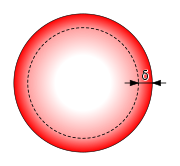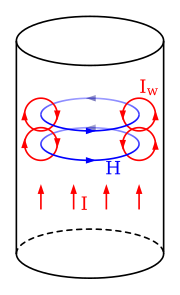Portions of this blog have been transcribed in summary from Wikipedia (page name: Skin effect)
In electromagnetism, skin effect is the tendency of an alternating current to become distributed within a conductor such that the current density is largest near the surface of the conductor at a level called the skin depth (δ). Skin depth depends on the frequency of the alternating current; as frequency increases, current flow moves closer to the outer surface. This is due the changing magnetic field (H) creating an electric field which produces a magnetic field in and around the conductor. When the intensity of current in a conductor changes, the magnetic field also changes. The change in the magnetic field, in turn, creates an electric field which opposes the change in current intensity. This opposing electric field is called “counter-electromotive force” (back EMF). The back EMF is strongest at the center of the conductor, and forces the conducting electrons to the outside of the conductor.


A power or signal cable may contain many alternating current components ...including RF noise. This means that inside a typical audio cable currents of different frequency move at different skin depths; with the unwanted high frequency RF noise currents moving closer to the surface. For example in copper, at 60 Hz (AC), the skin depth is about 8.5 mm; at 17kHz (audible limit), the skin depth is 0.5mm; at 170Mhz (RF noise), the skin depth is 0.005mm.
A skin effect filter is an engineered conductor that uses proprietary methods (chemical deposition or 3D printing) to provide increased resistance to current flow at specific diameter cross-sections. Unlike a traditional low pass filter which leverages the frequency response of a circuit, a skin effect filter directly impedes electron flow along a signal path. Consider the analogy of a thumb on a mechanical vibration: a skin effect filter attenuates electromagnetic "vibration" or RF noise. The attenuation applies to RF noise from the source power supply or from the component itself.
The AudioWise RF-STOP EXTREME DC filter is available as either i) LRC with three stages of Inductor-Resistor-Capacitor filters, or ii) SE with four stages of skin effect filters. These applied together in combination provide endgame filtering of DC power to a DAC or OPTO-DX (receiver). The skin effect filters operate on both power and ground conductors. The low pass drop-off frequency is 50kHz with an attenuation well in excess of 190dB resulting in a remarkable improvement to a resolution/transparency of a DACs ultra sensitive D/A stage.

